Understanding glass-like Vogel-Fulcher-Tammann equilibration times:
microcanonical effective temperatures in quenched 3D martensites
Abstract
We do Monte Carlo simulations of four 3D structural transitions, with vector-spin models of their martensitic strain domains under quenches to , to test a generic post-quench Partial Equilibration Scenario (PES) of Ritort. We indeed confirm that energy-lowering passages between fixed-energy shells induce a signature PES distribution of an exponential tail in heat releases, scaled in an effective search temperature. A linear vanishing of this at a temperature where PES passage-searches freeze, explains the Vogel-Fulcher like divergence of equilibration times , extracted from incubation-time delays of simulations and martensitic alloys.
Glassy freezing or structural arrest of a rapidly cooled liquid or colloidal system R1 ; R2 ; R3 ; R4 ; R5 that pre-empts crystallisation, has been investigated for more than a century. Supercooled liquid models can yield heterogeneous domains of competing crystal structuresR3 ; R5 . Equilibration time divergences at a glassy freezing temperature , have been fitted to Vogel-Fulcher-Tammann (VFT) , or other forms R2 ; R4 . It is natural to study generic equilibration scenarios R6 ; R7 ; R8 ; R9 in specific structural-domain systems that have long relaxation times R1 ; R2 ; R3 ; R4 ; R5 ; R10 ; R11 ; R12 ; R13 ; R14 ; R15 ; R16 .
After a sudden quench, a system on a free energy landscape, has competing pathways to the new global minimum, delayed by free energy barriers . The delay rates will be from energy barriers ( and entropy barriers (), schematically depicted in Fig 1. Ritort and colleagues R6 ; R7 ; R8 ; R9 have proposed a Partial Equilibration Scenario (PES) for re-equilibrations delayed by entropy barriers. Over a waiting time , a post-quench ageing system rapidly explores configuration shells of energy , entropy , and (inverse) micro-canonical effective temperature . Passages to a lower shell of are driven by spontaneous heat releases () to the bath at . The PES says that an iteration of these cooling steps ratchets the system down to the new canonical equilibrium. The non-equilibrium probability distribution for energy changes R6 ; R8 is peaked at positive energies, with an exponential tail for , whose fall-off determines the effective temperature. The PES distribution has been studied by analytic Monte Carlo (MC) methods for harmonic oscillators R8 , and by numerical MC simulations of spin glasses and Lennard-Jones liquids R7 ; R9 . We note that if the effective temperature of the heat-release probability vanishes at some , then there is an arrest of the PES cooling process.

We consider solid-solid structural transitions of martensites R10 ; R11 ; R12 ; R13 ; R14 ; R15 ; R16 , quenched below a thermodynamic , with competing domains and slow relaxations R11 ; R17 . Martensites undergo first-order, diffusionless transitions R5 ; R10 from the higher-symmetry austenite, with atomic shifts locked to their unit-cell distortions (‘military transformations’). The order-parameter strains have degenerate lower-symmetry ‘variants’ separated by crystallographically oriented Domain Walls (DW), that can form complex microstructures R10 ; R14 ; R15 . A long-standing puzzle R11 ; R12 is that while quenches of austenite to below an (athermal) ‘martensite start’ temperature results in avalanche martensitic conversions, quenches above it , show delayed conversions instead of no conversions. Resistivity, as a transition diagnostic, is flat during post-quench ‘incubations’, that end in sudden drops at a delayed avalancheR11 . Delays rise sharply, for shallower quenches approaching a third temperature that is in between, . When a bath quench goes a few percent closer to , the resistivity-drops go from a few seconds after, to ten thousand seconds after, the temperature quench R12 .
In this Letter we do MC simulations in three dimensions, with vector order parameter strains, for four structural transitions R18 . We present here the cubic-tetragonal (CT) transitionR15 , with a strain order parameter of components , with three competing unit-cell ‘variants’ . We confirm for all four transitions, that the PES energy change distribution has the predicted generic behaviour: an exponential tail, with an effective temperature that regulates heat releasesR6 ; R7 ; R8 ; R9 .
For our specific case of quenches across a first order transition, the Order Parameter (OP) rises from zero, enabling the waiting time to be defined by rising-OP marker events at , that depend on . This choice induces quench-temperature dependences: and . For passages to lower energy shells, the OP evolution must satisfy -controlled entropy-barrier constraints, postulated as of two types: a) A constraint that OP configurations must find and enter a Fourier space bottleneck that is like a Golf Hole (GH) that funnels into fast passage, as suggested for protein folding R19 ; or b) A constraint that the OP states need transient catalysts to enable fast passages, as inspired by facilitation modelsR20 ; R21 ; R22 . Our case is a), and we find a linear vanishing . The ‘search freezing’ temperature occurs at a pinch-off on warming, of the -space inner radius of an angularly modulated bottleneck. Equilibration times are exponential in entropy barriers R11 ; R12 ; R23 , and for quenches , diverge as . Thus VFT -like behaviour is not restricted to the glass transition. Conversely, entropy barriers vanish and delay times collapse for , when the bottleneck expands on cooling to span the Brillouin zone.
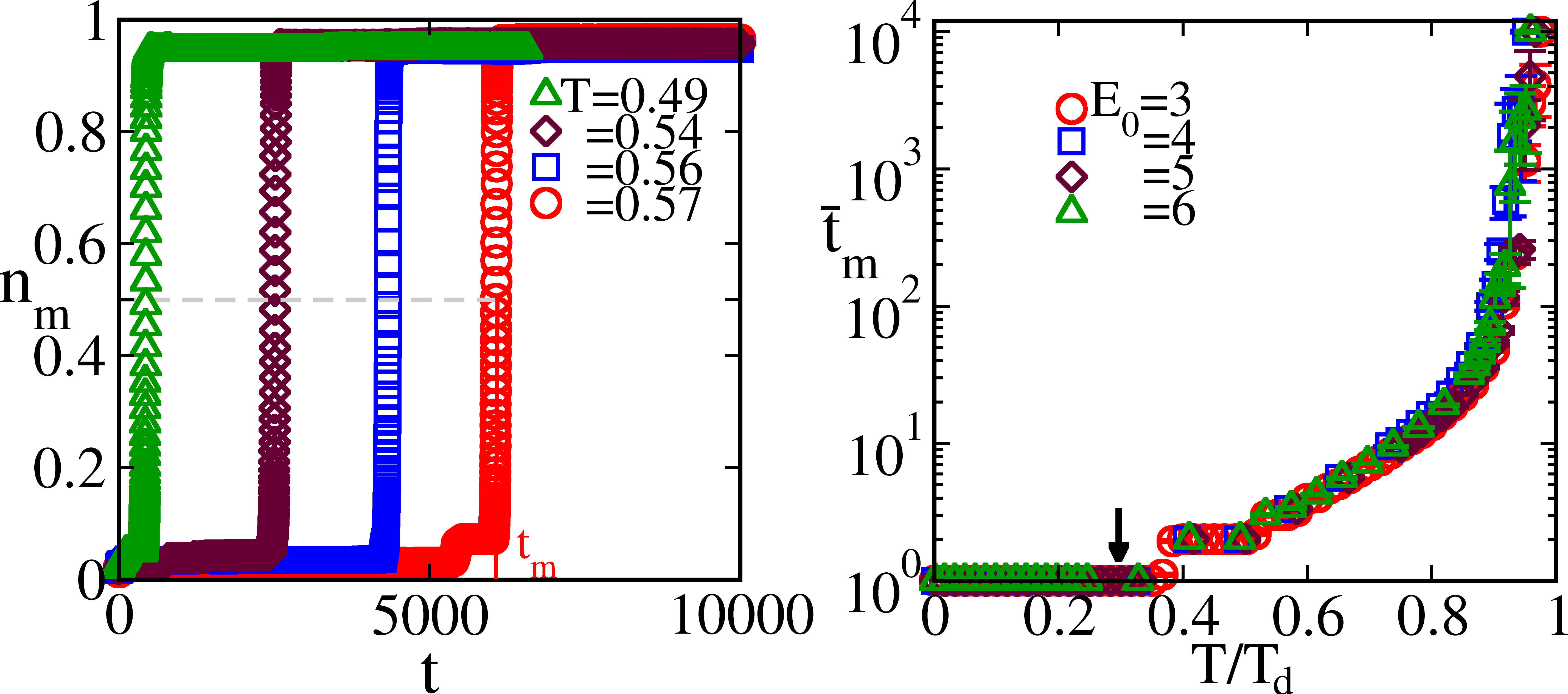
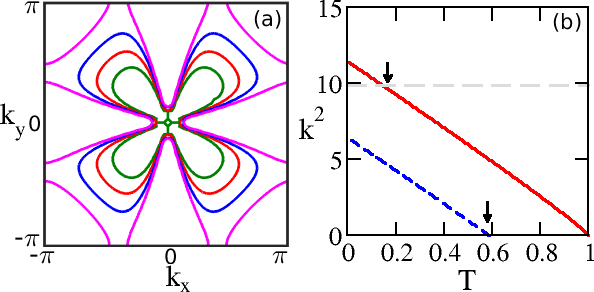
We derive a discretized-strain Hamiltonian R15 in 3D, from a crystal-symmetry invariant strain free energy , that has Compatibility R14 , Ginzburg, and Landau terms in , with an energy scale. There are six independent physical strainsR15 in 3D, that are linear combinations of Cartesian tensor strains: compressional ; deviatoric or rectangular , and shear . The OP of the cubic-tetragonal (CT) transition are two deviatoric strains . Austenite is .
The remaining non-OP strains (one compressional and three shears) enter the Hamiltonian as harmonic springs. These are minimized subject to a linear St Venant Compatibility constraintR14 that says no dislocations are generated: the double-curl of the strain tensor must vanish. There are three independent algebraic equations in space, connecting OP and non-OP strains R15 . The harmonic non-OP strains then analytically yield an OP-OP interaction, whose transition-specific, anisotropic Compatibility kernel R15 is a matrix, where . There is a prefactor of , and dependence on direction .
The Landau free energy for CT is and has 4 minima, at variants plus at zero strain. Here , and at the spinodal , while at the first-order transition temperature, scaled to be unity .
In ‘polar’ coordinates, . Here the unit-magnitude ‘variant vectors’ specify the unit-cell variants on either side of a Domain Wall (DW), that can be martensite-martensite or martensite-austenite. The nonzero martensite-variants have spins R15 , pointing to corners of an equilateral triangle in a unit circle, while the centroid is austenite. Thus or .
The degenerate Landau minima are at mean-OP magnitudes . The variant domains have mostly-flat strain magnitudes, approximated by . Substituting , the Landau term becomes . Here , where . At , the OP is unity and .
Notice a separation of time scale responses to quenches: the OP magnitude responds immediately, at , while Domain Walls can take thousands of time steps , to evolve successively from DW Vapour to DW Liquid to a DW Crystal of twins. For our case of shallow quenches , it is the DW Vapour-to-Liquid conversion has the long (bottleneck type) delays studied here. See VideosR21 A,B. The DW moves by correlated flips of spins that bracket it, while domain spins remain locked: a dynamical heterogeneity in space and time R3 ; R5 . [For deeper quenches not studied here, it is the DW Liquid-to-Crystal twin orientation that has long (facilitation type) delays. See VideoR21 C.]
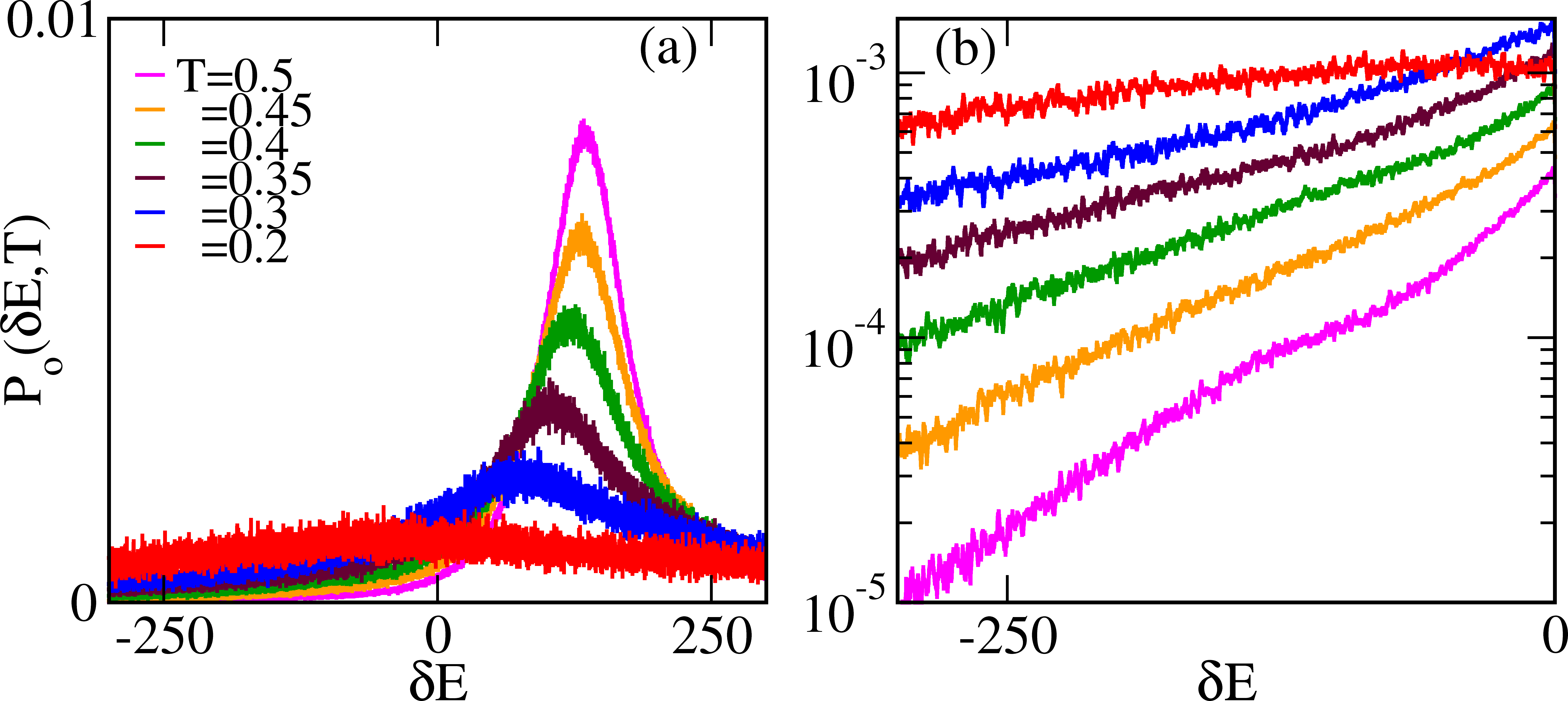
The total hamiltonian is , without extrinsic disorder. It is diagonal in Fourier space,
| (1) |
with . The spectrum, with and , is
| (2) |
The anisotropic Compatibility kernel in the energy spectrum can induce preferred DW orientations R14 ; R15 ; R16 ; R21 . For example the kernel is smallest at the most favoured orientation, and largest for most disfavoured. The negative sign of the Landau term and the positive signs of the Ginzburg term and the Compatibility term imply the spectrum could vanish along some Fourier contour. This contour will be angularly modulated, through the anisotropy of the Compatibility kernel R15 ; R16 .
In MC simulations, the initial state is high-temperature austenite that is randomly and dilutely () seeded with martensite unit-cells. Typical parameters are ; ; ; ; system volume ; ; and holding times MC sweeps.The martensite fraction is , with or for uniform austenite or martensite. The conversion time is defined as when R16 . An athermal martensite droplet or embryo can rapidly form anywhere, and after waiting till , can propagate rapidly to the rest of the system R13 . Hence it is mean rates (or inverse times), that are averaged over runs, analogous to total resistors in parallel determined by the smallest resistance. Mean times are inverse mean rates: .
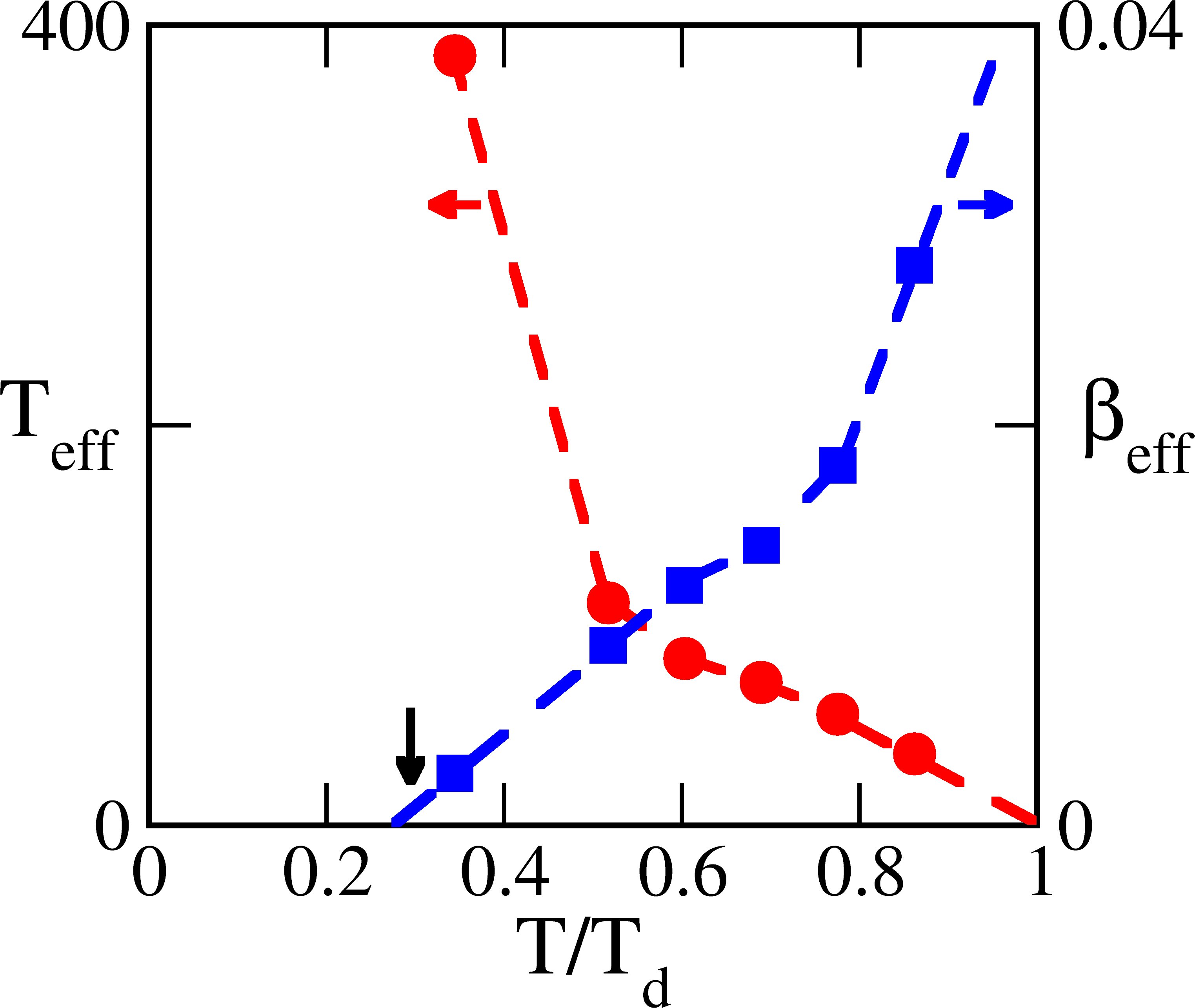
The MC procedure is standard, but with a crucial extra data retention R6 ; R7 ; R8 ; R9 of energy changes.
0. Take sites, each with a vector spin of components, in one of possible values (including zero) at MC time . Each set is a ‘configuration’.
1. Randomly pick one of sites, and randomly flip the spin on it to a new direction/value, and find the (positive/negative) changes for the new configuration.
2. If the energy change , then accept the flip. If , then accept flip with probability . Record this , that is not usually retained after use.
3. Repeat steps 1 and 2. Stop after such spin-flips. This configuration has the conversion fraction .
4. We collect R24 all from each spin-flip (configuration change) within each MC sweep of every run, up to the conversion time for that run, .
The set size has up to data points. We take six quenches, from up to .
Figure 2a shows , the martensite conversion-fraction in a single run, versus MC time for different temperatures . For quenches , avalanche conversions, characteristic of athermal martensite, occur in the very first sweep over all spins (). We identify with the martensite start temperature R11 ; R12 . For higher temperatures , there is a curious ‘incubation’ period, when nothing happens macroscopically, until a postponed avalanche at . These modelsR16 ; R24 display the delayed transitions and burst-like growth of order, characteristic of martensites and manganites R11 ; R12 ; R17 . Fig 2b shows that for above (downward arrow), and approaching , the mean incubation delays rise steeply, due to entropic bottlenecks.
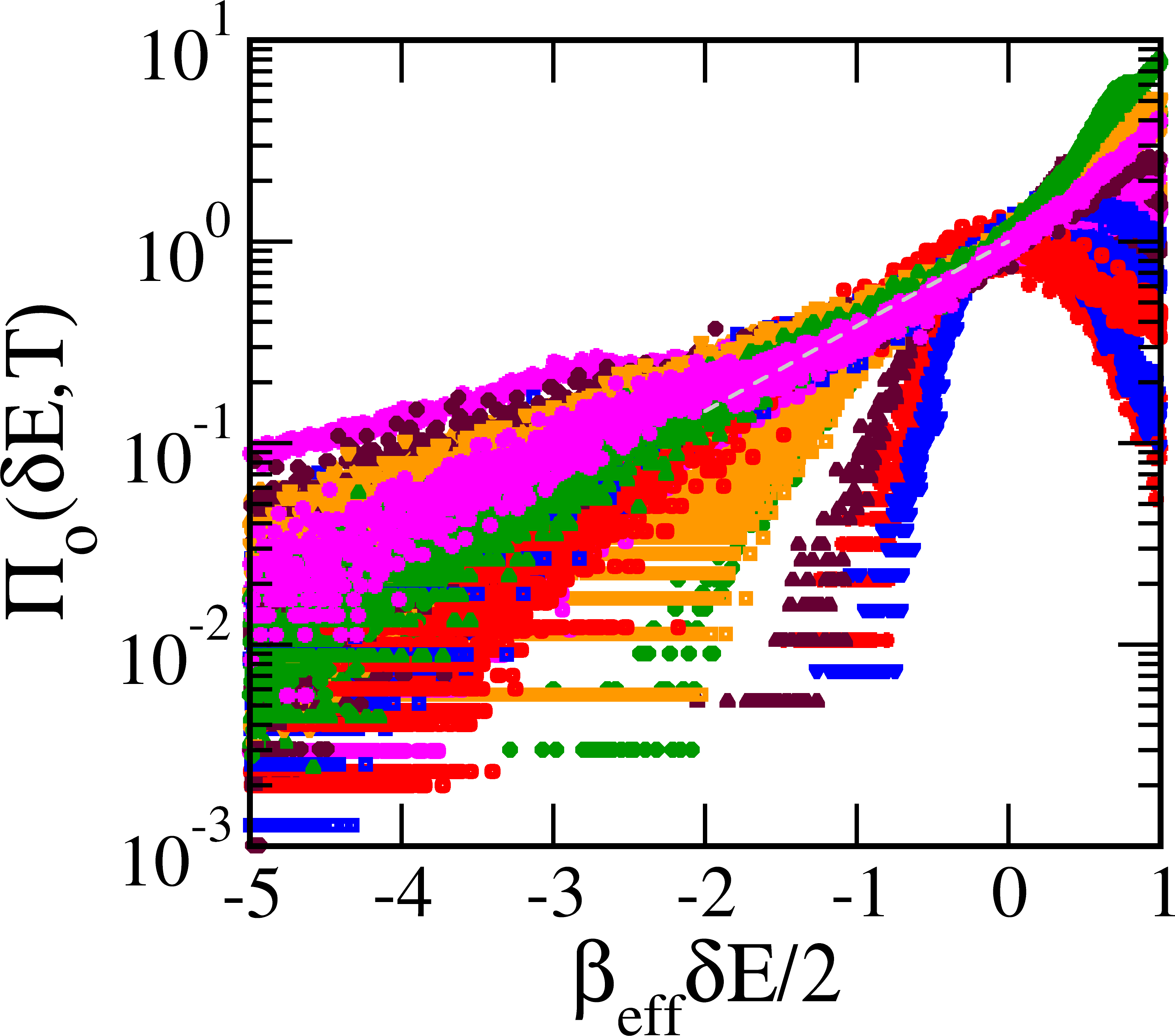
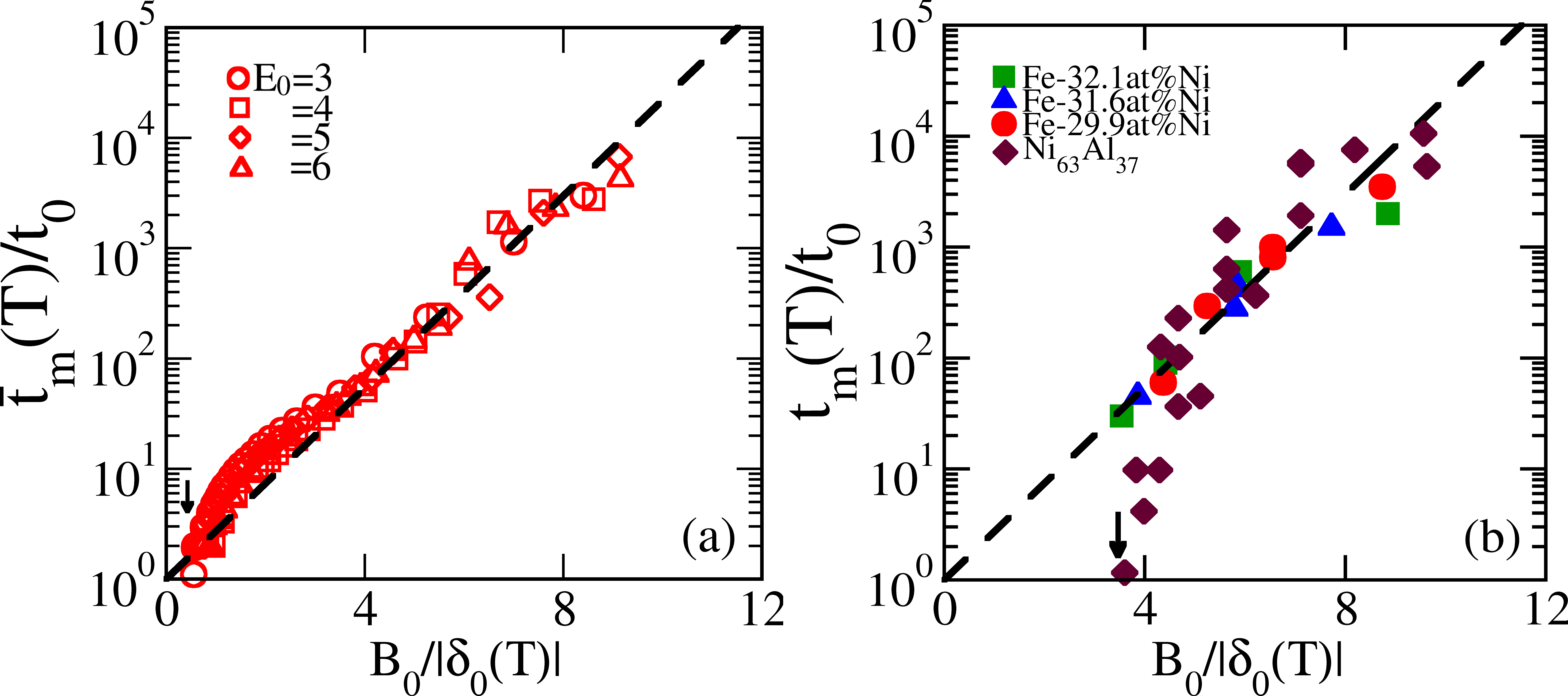
For our model, the boundary of a 3D bottleneck is from the spectrum set equal to zero , defining an anisotropic surface in -space. For the CT case, a [1,1,1] slice can intersect the bottleneck surface as an open, butterfly-shaped locus with an inner and outer radius, inside the Brillouin Zone (BZ). See Fig 3. For , the radius is larger than a BZ scale , and martensitic passages are immediate. For the butterfly bottleneck shrinks on warming. At , the inner squared-radius vanishes, and the topology of the connected butterfly changes to that of a segmented four-petaled flower: entropy barriers diverge, and PES heat releases are arrested. For the ‘precursor’ region R14 , PES passages are energetically available, but entropically inaccessisible. Repeated bottleneck entry attempts could induce vibrations. See VideoR21 D. Finally, at , the outer squared-radius also vanishes: the bottleneck becomes a point, and only austenite exists.
We collect the changes to the energy . The probability to access from , is proportional to the number of target states . With , the probability ratio of energy changes is related to the entropy change by a fluctuation relation for aging R1 ; R2 ; R3 ; R4 :
| (3) |
Entropy barriers rise, when the searched-for states become rarer. Since , the entropy change is odd, , and a solution for the PES distribution is
| (4) |
with an even . The leading entropy-change term for small heat releases is where . For , the Boltzmann-like form gives a physical meaning to the effective temperature, as a search range denoting accessible energy shells. If , entropy barriers collapse, and passages are immediate. If , then entropy barriers diverge, and passages cease. Glass-like freezing is a shutdown of PES searches.
Fig 4a shows that, as in PES models R6 ; R7 ; R8 ; R9 , the peaks are at positive , understood as a completion-of-square between a gaussian peaked at the origin and an exponential tail for . Fig 4b shows a zoom-in near the origin, where the slopes define .
Fig 5 shows the dependence of and on the quench temperature . The data suggest a linear vanishing of near , at a search freezing and a suppression of the heat releases to the bath. There is also a linear vanishing of near , at a search avalanche and prompt equilibration.
Fig 6 shows log-linear plots for a scaled versus the entropy-barrier related variable . Data are for four 3D structural transitions R18 ; R23 , and six between the collapse () and divergence () of entropy barriers.
The mean conversion time is exponential in the entropy barrier R23 , so near we have , where the constants can be fixed by simulational and experimental data R24 . The initial slope in of gives ; and the extrapolated intercept of versus gives . For Ni-Al data R11 the ‘fragility’ parameter R2 Kelvin, and the austenite-martensite DW hop time is sec.
Fig 7a shows that CT times show VFT behaviour near and fall-off behaviour near . Fig 7b shows data extracted from Ni-Al and Fe-Al alloysR11 ; R12 are similar.
Signatures of PES could be sought, in previous simulations or experimentsR3 ; R5 under systematic temperature quenches, with a recording of energy releases.
Further experimental work on martensitic alloys R11 ; R12 could record signal and noise under systematic quench steps of , over the delay region ; as well as the precursor R14 ; R21 region above it. Non-stationary distributions of energy releases might be determined through concurrent resistive, photonic, acoustic, and elastic signalsR25 . Finally, one might speculate that complex oxides quenched near their structural/ functional transitions, could show PES ageing behaviour in their (strain-coupled) functional variablesR17 ; R18 .
In summary, post-quench ageing in athermal martensites shows characteristic signatures of the Partial Equilibration Scenario. The conversion arrest and delay-divergence found in 3D simulations and alloy experiments, are understood as arising from a vanishing of the search temperature that governs the PES cooling process.
Acknowledgement: It is a pleasure to thank Smarajit Karmakar for valuable discussions on the glass transition.
References
- (1) K. Binder and W. Kob, Glassy Materials and Disordered Solids, World Scientific, Singapore (2005).
- (2) A.L. Greer, K.F. Kelton, S. Sastry, Eds.,Fragility of glass-forming liquids, Hindustan Book Agency, New Delhi (2014).
-
(3)
P. Harrowell, Nature Phys 2, 157 (2006);
H. Shintani and H. Tanaka, Nature Phys 2, 200 (2006);
X. Yang, H. Tong, W-H. Wang, and K. Chen, Phys. Rev. E, 99, 062610 (2019). - (4) P. Lunkenheimer, S. Kastner, M. Koehler and A. Loidl, Phys. Rev. E 81, 051504 (2010).
- (5) H. Fang, M.F. Hagan, W.B. Rogers, Proc. Nat. Acad. Sci., 117, 27927 (2020).
-
(6)
F.Ritort, J.Phys. Chem B 108, 6893 (2004); and in
Unifying Concepts in Granular Media and Glasses, (eds.) A. Coniglio, A. Fierro, H.J. Hermann and M. Nicodemi, Elsevier (2004); arXiv/ condmat/ 03113710v1. - (7) A. Crisanti and F. Ritort, Europhys. Lett., 66,253 (2004).
-
(8)
L. L. Bonilla, F.G. Padilla and F. Ritort, Physica A 250, 315 (1998);
L. Garriga and F. Ritort, Phys. Rev. E 72, 031505 (2005). - (9) A. Crisanti, M. Pecco and F. Ritort, Phys. Rev. Lett., 110, 080601 (2013).
- (10) K. Bhattacharya, Microstructure of Martensite, Oxford University Press (2003).
- (11) T. Kakeshita, T. Fukuda and T. Saburi, Scripta Mat. 34, 1 (1996); T. Kakeshita, K. Kuroiwa, K. Shimuzu, T. Ikeda, A. Yamagashi, and M. Date, Mat. Trans. JIM, 34, 423 (1993).
-
(12)
M. Aspelmeyer, U Klemradt, L.T. Wood and S.C. Moss, Phys. Stat. Sol. (a) 174, R9 (1999);
L. Müller , U. Klemradt, T.R. Finlayson, Mat. Sci. and Eng. A 438, 122 (2006);
L. Müller, M. Waldorf, G. Gutt, G. Grubel, A. Madsen, T. R. Finlayson and U. Klemradt, Phys. Rev. Lett., 109,105701 (2011). -
(13)
P.R. Rios and J.R.C. Guimaraes, Scripta Mat., 57, 1105 (2007);
P.R. Rios, F.G. Cardoso, T.A. Neves and J.R.C. Guimaraes, in the Minerals, Metals and Materials Society, TMS 2015 144th Annual Meeting, Cham, Springer (2015), https://doi.org/10.1007/978-3-319-48127-2_84. - (14) S. Kartha, J. A. Krumhansl, J. P. Sethna, and L. K. Wickham, Phys. Rev. B 52, 803 (1995).
-
(15)
S.R. Shenoy, T. Lookman and A. Saxena, Phys. Rev. B 82, 144103 (2010). The kernels for the four 3D transitions are in an Appendix.
K.O. Rasmussen, T. Lookman, A. Saxena, A.R. Bishop, R.C. Albers and S.R. Shenoy, Phys. Rev. Lett., 87, 055704 (2001). -
(16)
N. Shankaraiah, K. P. N. Murthy, T. Lookman and S. R. Shenoy, Europhys. Lett. 92, 36002 (2010);
Phys. Rev. B 84, 064119 (2011); Phys. Rev. B 91, 214108 (2015). -
(17)
W.I.F. David,C.C. Wilson, P. P. Edwards, R. Jones, M.R. Harrison, Nature 331, 245 (1988);
M. Uehara and S-W. Cheong, Europhys. Lett., 52, 674 (2000);
V Podzorov, C.H. Chen, M.E. Gershenson and S.-W. Cheong, Europhys. Lett., 55, 411 (2001);
V. Podzorov, B.G. Kim, V. Kiryukin, M.E. Gershenson and S.W. Cheong, Phys. Rev. B 64, 140406 (R) (2001);
V. Hardy, A. Maignan, S. Hebert, C. Yaicle, C. Martin,M. Hervieu, M.R. Lees, G. Rowlands, D. McK. Paul and B. Raveau, Phys. Rev. B 68, R220402 (2003);
V. Hardy, S. Majumdar, S.J. Crowe, M.R. Lee, D. McK. Paul, L. Herve’, A. Maignan, S. Hebert, C. Martin, C. Yaicle, M. Hervieu and B. Raveau, Phys. Rev. B 9, 020407 (R) (2004). - (18) The four chosen structural transitions can occur in materials with useful functionalities R17 . The transitions are: tetragonal-orthorhombic (, superconductivity); cubic-tetragonal (, shape memory); cubic-orthorhombic (, ferroelectrics); cubic-trigonal (, colossal magnetoresistance).
-
(19)
D. J. Bicout and A. Szabo, Protein Science 9, 452 (2000);
P.G. Wolynes, Proc. Amer. Phil. Soc. 145, 4 (2001);
M. Cieplak and J.I. Sulkowska, J. Chem. Phys.,123,194908 (2005). -
(20)
F. Ritort and P. Sollich, Adv. Phys. 52, 219 (2003);
K. Otsuka, X. Ren, and T. Takeda, Scripta Mat. 45,145 (2001). -
(21)
Supplementary Material. [ URL]
Videos for the 2D square-rectangle transitions for systems, with austenite (green) and the two martensite variants (red/ blue), showR16 sequentially evolving Domain Wall states, from DW Vapour to DW Liquid to DW Crystal or oriented ‘twins’. The 3D physical evolutions are similar.
Video A. The droplet in -space: This shows the coordinate-space evolution for , for the bottleneck type passage. Random initial martensite seeds rapidly form a single-variant DW Vapour droplet, bounded by a martensite-austenite DW. This fluctuates like an amoeba, searching over incubation delays for a conversion passage to a DW Liquid, and then a quick symmetry-breaking to a DW crystal.
Video B. The droplet in -space: This shows the evolution as Video A but now in Fourier space. The dynamic structure factor for variant spins is shown in space, with elliptic contours of a DW Vapour going to the bi-diagonal X of a DW Liquid, and to a single-diagonal line of a DW Crystal.
Video C. The -space dynamic catalysts: This shows the evolution for deep quenches to , of the facilitation type passage R20 . The DW Vapour now converts rapidly to a sluggish DW Liquid of frozen walls. Transient hotspots of austenite in martensite act as facilitation variables or dynamic catalysts, that unlock and delete even far-off minority-diagonal DW segments, leaving a dominant-diagonal DW crystal, or twins R16 .
Video D. The -space tweed precursor: This shows (dynamical) tweed R14 in the precursor region , of an oscillating array of martensitic islands in austenite sea. This might arise from a space profile of the droplet, vibrating as it unsuccessfully attempts entry to a topologically blocked GH. - (22) S. R. Shenoy and T. Lookman, Phys. Rev. B 78, 144103 (2008), see Fig 7.
- (23) The mean equilibration rate is the average over an inter-shell rate over all heat releases. With a normalized PES probability, . For slow intershell variation , the mean rate is proportional to the acceptance fraction over energy decrements. Taking the PES probability, as a shifted gaussian with peak mean energy change , and variance , the acceptance fraction is a complementary error function, whose asymptotic behaviour yields . Dropping constants, the martensitic mean conversion time near is written simply as .
- (24) N. Shankaraiah, K.P.N. Murthy and S.R. Shenoy, submitted.
-
(25)
U. Chandni, S Kar-Narayan, A. Ghosh, H.S. Vijaya and S. Mohan, Acta Mater., 57,6113 (2009);
A. Planes, Ll. Manosa and E. Vives, J. Alloys and Comp., 577, S699 (2013);
X. Balandraud, N. Barrara, P. Biscarin, M. Grediac, G. Zanzotto, Phys. Rev. B, 91,174111 (2015);
B. Blaysat, X. Balandraud, M. Grediac, E. Vives, N. Barrera and G. Zanzotto, Nature Commun. Mater., 1,3 (2020); Z. Eranson, B. Ruta, S. Hechler, M. Stolpe, E. Pineda, I. Gallimo, and R. Busch, Phys. Rev. Lett., 115, 175701 (2015).See also Physics 8, S5121 (2015).